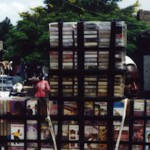Monday, March 2, 2015 at 6:00 pm to 7:45 pm
Jeanne Liotta, Artist and Filmmaker, University of Colorado Boulder Film Studies and the Bard MFA Program
Abstract: Last year I had the extraordinary opportunity to work on a special media project in collaboration with climate change scientists at NOAA. I am still processing the experience of this experimental think tank which raised questions about methods, materials, and outcomes, fueled in turns by enthusiasm and nihilism.
Monday, March 9, 2015 at 6:00 pm to 7:45 pm
Brian Larkin, Barnard College, Columbia University
Abstract: This paper examines the use of loudspeakers in Nigeria, particularly their implication in religious violence, to examine the technologizing of everyday life in Nigeria. It draws on loudspeakers to show how the operation of technology forms a medial base that organizes urban experience.
Monday, March 16, 2015 at 6:00 pm to 7:45 pm
Joe Inzerillo, Executive Vice President, Chief Technology Officer, MLB (Major League Baseball) Advanced Media
Bio: Mr. Inzerillo oversees all aspects of technology for MLBAM, including the MLB.com portal and 30 team sites as well as dozens of sports and entertainment partners across the internet, mobile and interactive spaces.
Monday, March 30 at 6:00 pm to 7:45 pm
Laura Kurgan, Associate Professor of Architecture; Director, Spatial Information Design Lab; GSAPP Columbia University
Abstract: Laura Kurgan will present recent work from Spatial Information Design Lab. SIDL is known for converting information that is otherwise dormant, invisible, or simply incomprehensible into images and arguments that provide grounds for research, discovery, and action.
Notes on/response to Brian Larkin’s presentation:
“Techniques of Inattention: Religion and the Mediality of Loudspeakers in Nigeria” March 9, 2015 @ The New School, NYC
| “Secular Machines” | Why Loudspeakers? | Sonic vs. Visual Media |
|---|---|---|
|
|
|

Loudspeaker on Bicycle (Northern Nigeria) – Source: Brian Larkin “Techniques of Inattention: Religion and the Mediality of Loudspeakers in Nigeria”
|

NYC Street – Source: “USA-NYC-Koreatown99” by Ingfbruno
|
|
Acoustic Violence and Inattention
- The aggressive religious soundscape in Nigeria facilitates religious division among residents
- Nigerians must practice inattentiveness and dismiss religious media they do not affiliate with
- At what point does sound become violence?
Media and Inattention—A Problematic Relationship
In media-rich urban cultures, where the visual and sonic assault can be at times overwhelming, we urban dwellers often have to cultivate techniques of inattention. We have to learn how to filter media and their messages—particularly those that seem to be aimed at different target audiences. But to what end?
Media and consumer inattention evolve in parallel. They form a positive feedback loop. As consumers become better at filtering media, media become more difficult to filter – more aggressive. The volume knob on the loudspeaker gets turned up, so to speak. And at a certain point, it can become violent. The aggressive religious soundscape that exists in Nigeria, for instance, facilitates a sense of religious division (intolerance even) among residents. The loudspeaker, then, can be seen as a sonic weapon—a form of acoustic violence—that plays a role in aiding the conflict between religious organizations in Nigeria. Media that forces itself upon consumers in this way can be seen as an weapon of violence that should be confronted.
Inattention has a breaking point. If we step back and look at media from a purely marketing standpoint, its basic purpose is to encourage consumers to support a message. It could be argued that imposition plays no role in this. As soon as a consumer is forced to attend to a message, despite her conscious efforts of inattentiveness, the experience becomes negative. However, as the loudspeakers in Nigeria show us, imposition is sometimes a fundamental purpose of media. As Larkin points out, the loudspeakers in Nigeria do not enhance the messages being relayed. In fact, the loudspeakers often distort the sound signals and are largely just a way to impose sonic control over a particular space. In such instances, media can be seen as an assault against the free will of residents. As technological media continue to evolve in response to consumer inattention, we need to cultivate better awareness and governance to appropriately balance the rights of media makers and the free will of consumers.



